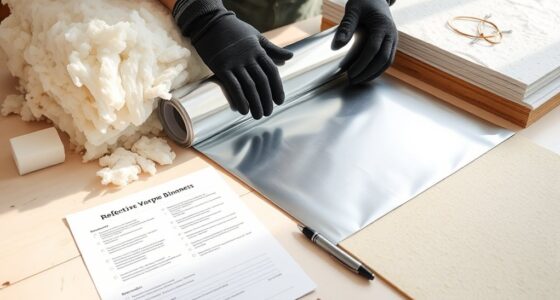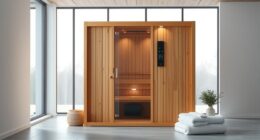To stay safe from CO and oxygen issues indoors, understand that carbon monoxide is a colorless, odorless gas from appliances like furnaces and stoves that can cause poisoning. Recognize symptoms like headaches, dizziness, and confusion, and always install CO detectors near sleeping areas. Guarantee proper ventilation, regularly service appliances, and monitor oxygen levels in your home. If concerns arise, acting quickly is crucial—continue to explore ways to protect your environment and loved ones.
Key Takeaways
- Carbon monoxide is a colorless, odorless gas from incomplete fuel combustion, posing serious health risks without detection.
- Regularly test and maintain CO detectors placed near bedrooms and on every home level for safety.
- Recognize early symptoms of CO poisoning and low oxygen levels: headaches, dizziness, confusion, and fatigue.
- Ensure proper ventilation, use exhaust fans, and keep appliances well-maintained to prevent indoor CO buildup.
- Protect pets by monitoring for symptoms and maintaining good airflow, as they are also vulnerable to CO poisoning.
What Is Carbon Monoxide and Why Is It Dangerous?
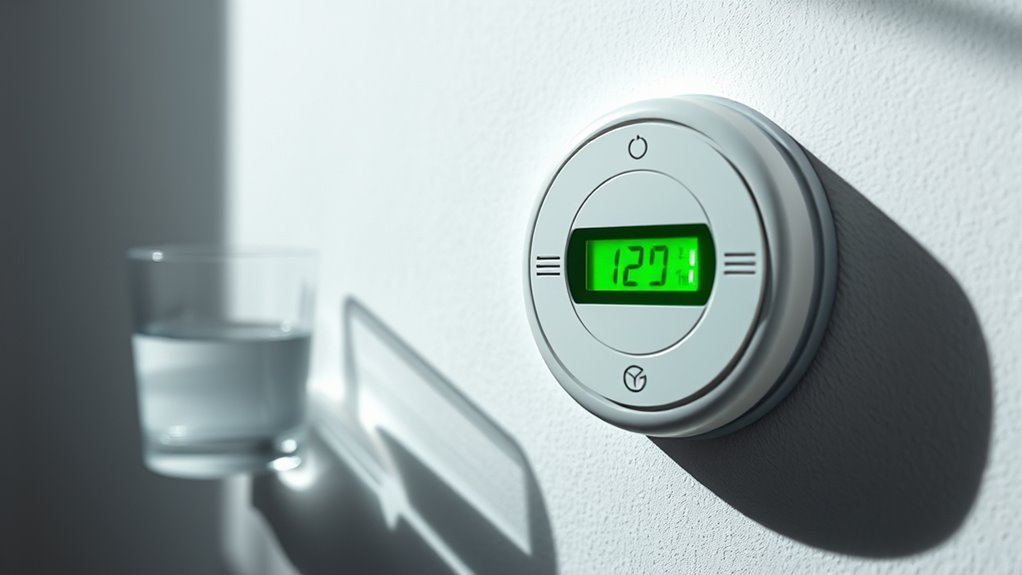
Carbon monoxide (CO) is a colorless, odorless gas that’s produced when fuels like gasoline, wood, or natural gas burn incompletely. Because it’s invisible and odorless, it can easily compromise your indoor air quality without you noticing. This makes it especially dangerous in enclosed spaces where ventilation is poor. Poor indoor air quality from CO buildup can lead to serious health risks, including poisoning. To stay prepared in an emergency, you should install CO detectors and ensure proper ventilation around appliances that burn fuel. Understanding what CO is and how it affects your environment helps you take proactive steps to protect yourself and your loved ones. Being aware of these risks is key to effective emergency preparedness and maintaining a safe home. Additionally, understanding the sources of carbon monoxide exposure can help prevent accidental poisoning.
How to Recognize the Signs of CO Poisoning

Since CO poisoning can develop quickly and subtly, it’s important to recognize its early warning signs. You might feel headaches, dizziness, or nausea even if your indoor plants seem healthy and your air quality appears good. Low oxygen levels from CO can cause confusion, weakness, or shortness of breath. If several family members experience these symptoms simultaneously, it’s a red flag. Be alert to unusual fatigue or flu-like symptoms that don’t improve. Keep in mind that indoor plants don’t affect CO levels but can give a false sense of safe air quality. Regularly check for symptoms, especially in homes with appliances that produce combustion. Being aware of oxygen levels and their impact on health can help you take timely action. Recognizing these signs early can save lives and prevent serious health consequences.
The Importance of Proper Ventilation and Air Circulation
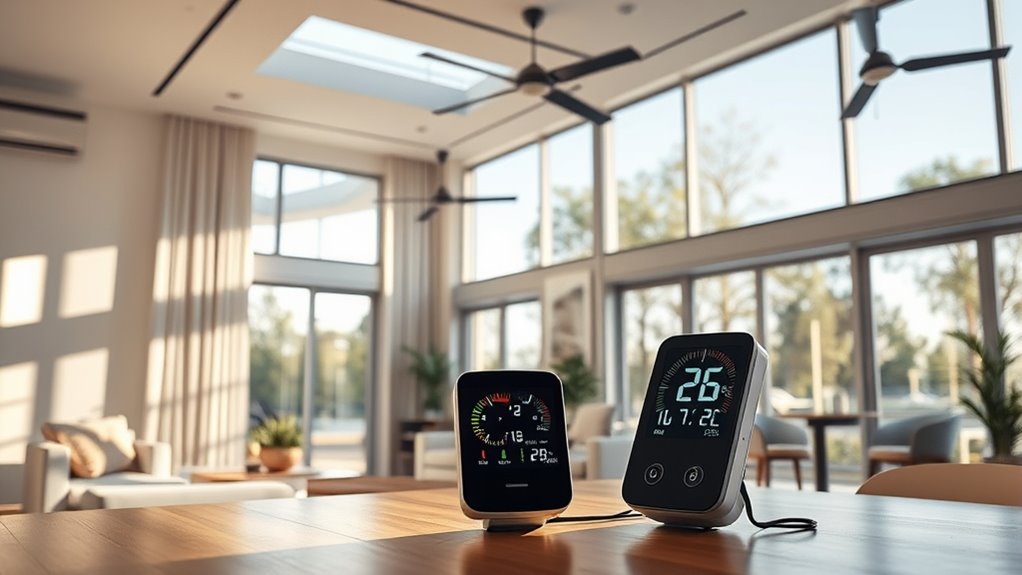
Proper ventilation and good air circulation are essential for reducing the buildup of carbon monoxide and other indoor pollutants. Without fresh air, CO levels can rise unnoticed, risking your health. Regularly opening windows or using exhaust fans helps dilute indoor pollutants and improves air quality. Indoor plants also aid air purification, naturally filtering toxins and increasing oxygen levels. To maximize airflow, consider arranging furniture to avoid blocking vents and using fans strategically. Here’s a quick comparison:
| Benefit | How it Helps |
|---|---|
| Indoor plants | Remove toxins, boost oxygen |
| Air circulation | Prevents pollutant buildup, refreshes air |
| Ventilation | Reduces CO accumulation, improves health |
| Circulating air | Distributes fresh air evenly |
Additionally, selecting office chairs for neck pain relief can promote better posture during long periods of air quality management.
Installing and Maintaining CO Detectors
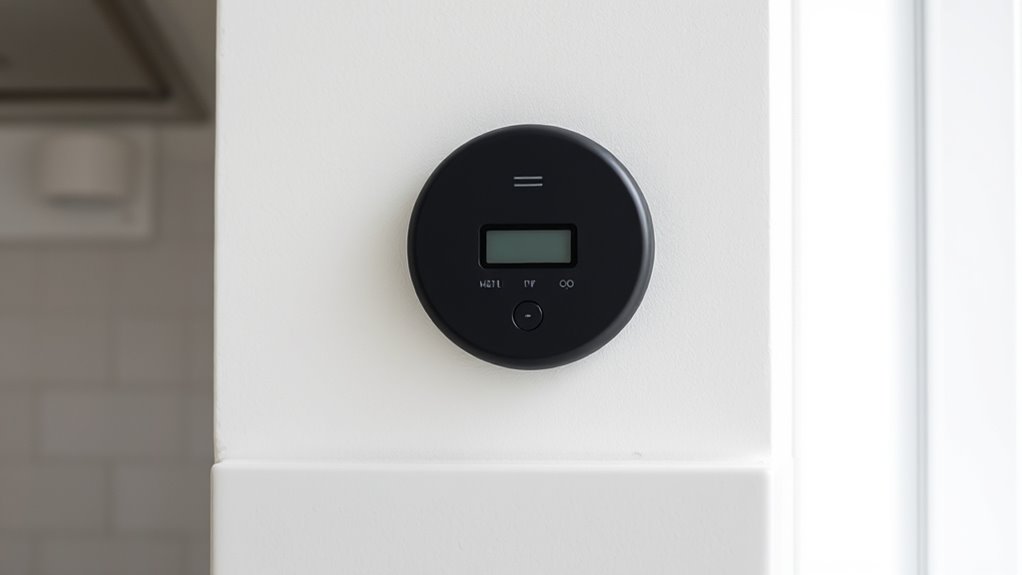
To keep your home safe, you need to install CO detectors in the right spots, such as near bedrooms and on every level. Once installed, make sure to test them regularly and clean or replace batteries as needed. Proper placement and maintenance guarantee your detectors will alert you promptly to any danger. Regularly checking and understanding exploration quotes can also inspire vigilance and proactive safety measures.
Proper Detector Placement
Installing CO detectors in the right locations is vital for early warning and safety. Proper detector placement ensures you’re alerted before dangerous levels build up. Place detectors on every level of your home, especially near bedrooms and living areas. Keep them at least 15 feet from fuel-burning appliances to avoid false alarms caused by normal emissions. Avoid placing detectors directly next to vents, windows, or ventilation systems, which can draw away CO or cause inaccurate readings. Instead, position them on the wall about 5 feet above the floor, where CO concentrations are likely to be highest. Correct placement maximizes detection efficiency, giving you essential time to react and protect your family from CO exposure. Additionally, understanding the importance of industry transformations, such as AI automation, can help you stay informed about emerging safety technologies.
Regular Testing & Maintenance
Once you’ve placed your CO detectors in the right spots, maintaining their functionality is key to ongoing safety. Regular testing guarantees they work properly, so set a schedule to check batteries and alarms monthly. Replace batteries at least once a year or as needed, especially if the detector starts to beep. Clean your detectors with a soft cloth to remove dust, which can interfere with their sensors. For optimal performance, consider filter replacements and ensure proper placement to avoid obstructions. Consistent maintenance improves fire safety and keeps indoor air quality high by reliably detecting dangerous CO levels. Follow manufacturer instructions for testing and replacement, and consider replacing detectors every 5-7 years. Staying proactive with testing and maintenance minimizes risks, giving you peace of mind and protecting everyone in your home.
Understanding Oxygen Levels and Why They Matter

Knowing your oxygen levels is essential for safety and health. When levels drop below the normal range, you may experience fatigue or dizziness, which can be dangerous. Using monitoring techniques helps you stay aware and take action before problems become serious. Understanding oxygen level accuracy can improve your ability to detect issues early.
Normal Oxygen Range
Understanding your oxygen levels is essential for maintaining overall health, as they reflect how well your body is receiving the oxygen it needs to function. Oxygen saturation measures the percentage of hemoglobin molecules carrying oxygen, and knowing your levels helps you assess your respiratory efficiency. The normal ranges for oxygen saturation are typically between 95% and 100%. Values below 95% may indicate insufficient oxygen, signaling potential health issues. Maintaining oxygen saturation within this range ensures your organs and tissues get the oxygen they require for ideal performance. Regular monitoring can help catch early signs of oxygen deficiency. If your levels consistently fall outside the normal range, it’s important to consult a healthcare professional to identify underlying causes and take appropriate action. For accurate readings, using a reliable oxygen monitor can be very helpful.
Effects of Low Oxygen
When oxygen levels drop below the normal range, your body struggles to perform essential functions efficiently. You may feel dizzy, tired, or short of breath as your brain and muscles receive less oxygen. Low oxygen also hampers your immune system and slows healing. Indoor plants can help improve air quality and increase oxygen levels naturally, supporting better health. They contribute to air purification by absorbing toxins and releasing oxygen, especially in enclosed spaces. Without enough oxygen, your focus and alertness decline, and you’re more vulnerable to headaches and fatigue. Recognizing the effects of low oxygen emphasizes the importance of maintaining good ventilation and healthy indoor environments. Additionally, advancements in air quality monitoring technology can help detect and maintain optimal oxygen levels in your environment. Ensuring proper oxygen levels helps your body function *ideal*ly, keeping you alert, energized, and healthier overall.
Monitoring Techniques
Monitoring oxygen levels is essential to guarantee your indoor environment remains safe and healthy. Using tools like air quality indices helps you assess overall air safety, including oxygen content. Oxygen sensors and detectors provide real-time data, alerting you when levels drop below safe thresholds. Maintaining proper oxygen levels supports respiratory health, preventing issues like fatigue, dizziness, or more severe conditions. Regularly checking your indoor air with these monitoring techniques ensures you catch problems early, especially in spaces with limited ventilation or high occupancy. Understanding the sources of pollutants helps in choosing the right purification strategy. By staying vigilant, you minimize risks related to low oxygen, improve overall air quality, and promote a healthier living or working environment. Effective monitoring is your first line of defense in safeguarding respiratory health and ensuring safe indoor air.
Common Sources of Carbon Monoxide in Homes
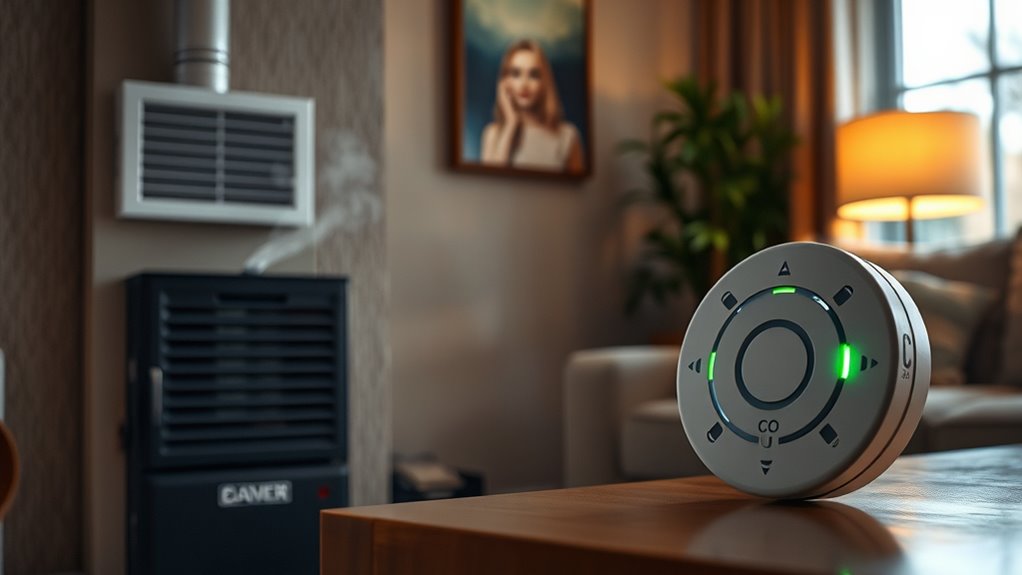
Many common household appliances and practices can produce dangerous levels of carbon monoxide if not properly maintained or ventilated. Poor indoor air quality often results from these sources, risking your health. Be aware of:
- Gas furnaces and boilers that leak or operate inefficiently, releasing CO into your home.
- Gas-powered appliances like water heaters, stoves, or dryers that aren’t properly vented.
- Portable generators used indoors or near open windows, which can quickly fill your home with CO.
Ensuring appliance safety and proper ventilation is vital for maintaining safe indoor air quality. Regular maintenance and correct use minimize CO buildup, helping protect your family from carbon monoxide poisoning. Stay vigilant about these sources to keep your home safe.
Tips for Safe Use of Heating and Cooking Appliances
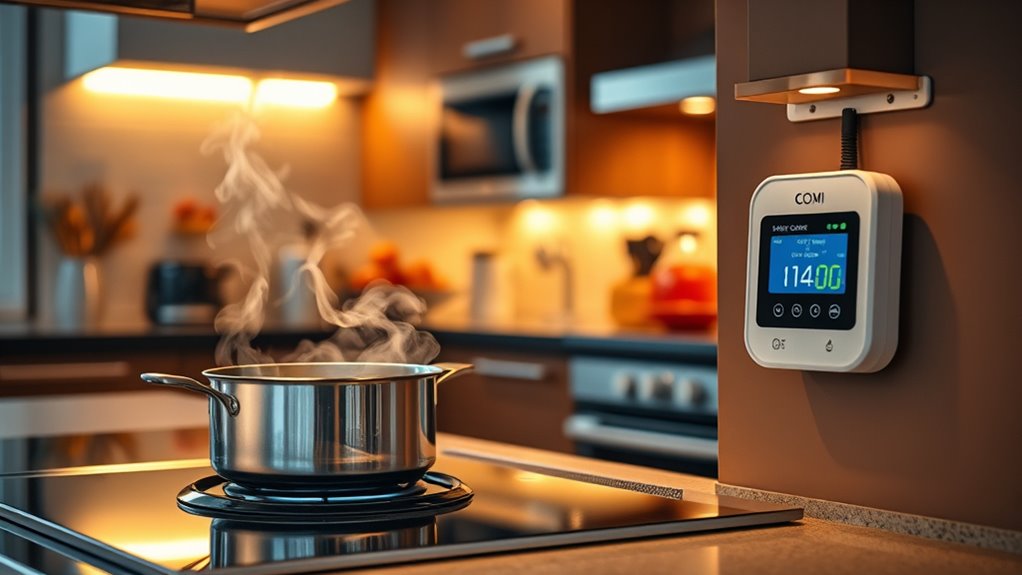
To prevent carbon monoxide buildup, always follow manufacturer instructions and guarantee proper ventilation when using heating and cooking appliances. Regularly check that vents and chimneys are clear to ensure safe appliance safety. Never block exhaust outlets or use appliances indoors that aren’t designed for indoor use. Proper fuel storage is essential; store fuels in well-ventilated, secure areas away from heat sources. Keep appliances well-maintained and inspect for leaks or damage regularly. Use carbon monoxide detectors near appliances and sleeping areas for added safety. Avoid using portable generators or grills indoors, as they produce dangerous CO levels. By following these tips, you reduce the risk of CO poisoning and maintain a safe environment during appliance operation.
What to Do If You Suspect CO Exposure

What should you do immediately if you suspect you’ve been exposed to carbon monoxide? Act quickly—your life may depend on it. First, get fresh air by opening windows and doors. Second, evacuate everyone from the building and call emergency services right away. Third, inform your community and emergency preparedness teams so they can respond appropriately. Remember, community education on CO risks helps everyone recognize symptoms early. While waiting for help, turn off potential sources of CO, like furnaces or stoves. Don’t attempt to fix equipment yourself if you suspect a leak. Stay outside until professionals declare the area safe. Quick action saves lives and prevents serious health consequences. Being prepared and informed makes all the difference in CO emergencies.
Keeping Pets Safe From Carbon Monoxide Risks
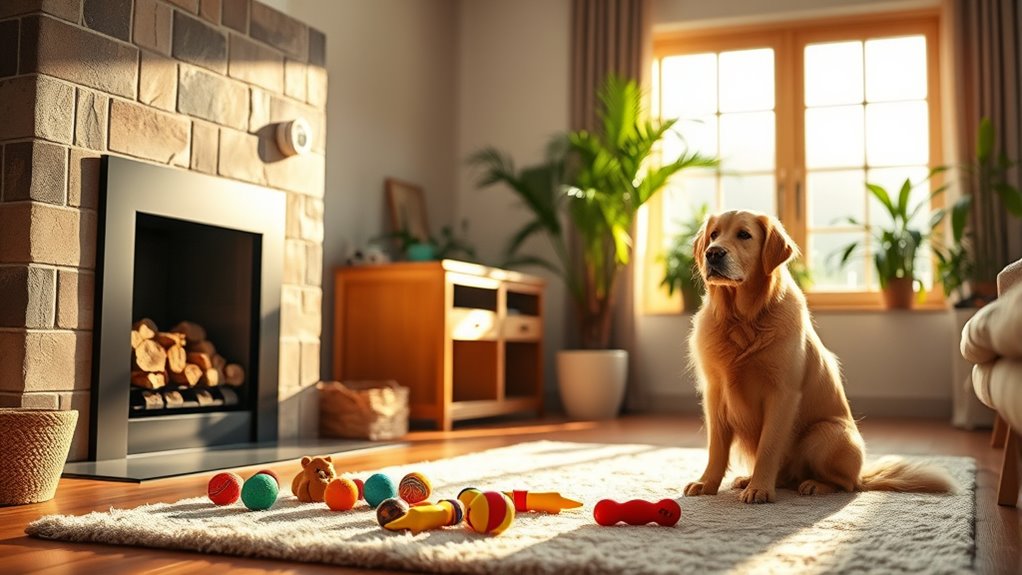
You need to be alert to signs of CO poisoning in your pets, like lethargy or difficulty breathing. Make sure your ventilation systems work properly and keep fuel sources stored safely away from living areas. Taking these steps helps protect your pets from the silent danger of carbon monoxide.
Recognize CO Poisoning Signs
Recognizing the signs of carbon monoxide (CO) poisoning is essential for keeping your pets safe, especially since they can’t tell you when they’re feeling unwell. Poor indoor air quality from CO leaks can quickly harm them. To stay ahead, watch for these symptoms:
- Lethargy or weakness, making your pet less active than usual
- Disorientation or confusion, which might cause them to stumble or act strangely
- Rapid or irregular breathing, indicating distress
Being aware of these signs helps you respond swiftly and prioritize emergency preparedness. If you suspect CO poisoning, immediately remove your pets to fresh air and seek veterinary care. Regularly check CO detectors to ensure your indoor environment remains safe for everyone.
Ensure Proper Ventilation Systems
Proper ventilation is key to preventing the buildup of carbon monoxide in your home. Good air flow ensures harmful gases don’t accumulate, protecting your pets and family. Focus on ventilation design that promotes continuous, balanced air exchange. Regularly inspect and maintain vents, exhaust fans, and chimneys to keep air moving freely. Properly designed systems prevent stale air pockets and reduce CO risks. Use the table below to evaluate your ventilation setup:
| Aspect | What to Check |
|---|---|
| Air flow | Is air circulating throughout all rooms? |
| Ventilation design | Are vents and fans correctly installed and clear? |
| Maintenance | Are filters cleaned and systems serviced regularly? |
Consistent attention to ventilation keeps your home safe and well-ventilated for your pets.
Store Fuels Safely
Storing fuels safely is essential to prevent carbon monoxide leaks that can harm your pets. Proper fuel storage reduces the risk of accidental spills or leaks that might lead to dangerous CO buildup. Follow these safety protocols:
- Keep fuel containers in well-ventilated, cool, and dry areas, away from pets.
- Use approved containers specifically designed for fuel storage to prevent leaks.
- Never store fuels inside your home or near heat sources, as fumes can quickly accumulate.
Simple Steps to Maintain a Safe Indoor Air Environment
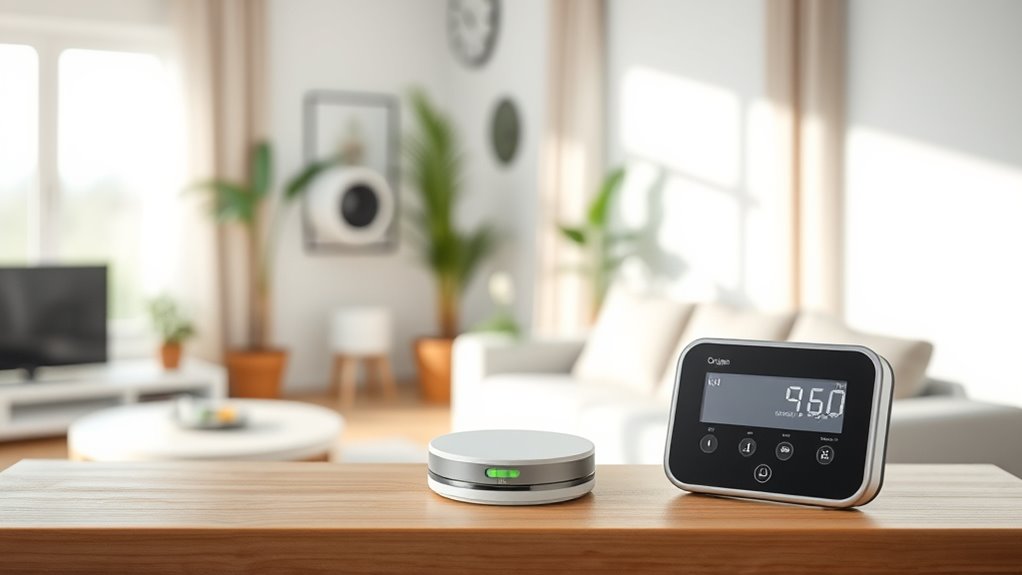
Ensuring your indoor air remains safe requires taking simple, proactive steps. First, keep your home well-ventilated by opening windows regularly and using exhaust fans in kitchens and bathrooms. This improves air quality and reduces the buildup of pollutants. Install carbon monoxide detectors near sleeping areas and fuel-burning appliances to alert you to dangerous levels. Regularly maintain furnaces, water heaters, and fireplaces to prevent emissions that can affect respiratory health. Avoid smoking indoors, as it considerably deteriorates air quality. Use air purifiers with HEPA filters to reduce allergens and airborne toxins. Keep furniture and carpets clean to minimize dust and mold. These small actions help maintain a healthy indoor environment, protecting your respiratory health and ensuring safe air for everyone in your home.
Frequently Asked Questions
How Often Should CO Detectors Be Tested and Replaced?
You should test your CO detectors monthly as part of regular detector maintenance to guarantee they’re working properly. Replace the detectors every 5 to 7 years, following the recommended replacement schedule from the manufacturer. Regular testing and timely replacement keep you safe by making sure the device detects dangerous carbon monoxide levels early. Don’t forget to check batteries and overall condition during each test for peak performance.
Can Indoor Plants Improve Oxygen Levels Effectively?
Indoor plants can improve oxygen levels and indoor air quality, but their effect is *considerably*. They benefit your indoor air by increasing humidity and reducing certain pollutants, making the environment healthier. However, to *substantially* boost oxygen levels, rely on proper ventilation and air exchange, not just plants. Incorporate plants for their aesthetic and air-purifying benefits, but don’t depend solely on them for oxygen enhancement.
Are There Any Health COnditions That Increase CO Poisoning Risk?
If you have respiratory diseases or cardiovascular conditions, you’re at a higher risk of CO poisoning. Imagine someone with chronic obstructive pulmonary disease (COPD) using a malfunctioning heater; they could unknowingly be exposed to dangerous levels of carbon monoxide. These health conditions make it harder for your body to absorb oxygen and clear CO, increasing the risk of poisoning even with low-level exposure. Stay vigilant, verify proper ventilation, and maintain your appliances.
What Are the Legal Requirements for CO Alarms in Homes?
You must install CO alarms in your home to meet legal compliance and safety standards. Typically, laws require alarms on every level, near sleeping areas, and sometimes in garages or attached workshops. Make sure your alarms are certified and functioning properly. Regular testing and maintenance are essential to ensure they work correctly. Staying updated with local regulations helps keep your household safe and compliant with the law.
How Does Altitude Affect CO and Oxygen Levels Indoors?
Altitude effects are like a thin veil over your indoor environment, making oxygen levels drop and CO build-up easier. As you go higher, it’s harder for your body to get enough oxygen, and indoor ventilation becomes even more vital. You might need more sensitive CO alarms, too. Keep windows open, make sure proper ventilation, and check your alarms regularly to stay safe, especially at higher elevations where risks increase.
Conclusion
By staying vigilant and following these simple steps, you’ll create an indoor environment as safe as a fortress. Regularly checking detectors, ensuring proper ventilation, and being aware of symptoms can help prevent CO dangers from sneaking in unnoticed. Think of your home as a gust of fresh air, where safety and peace of mind grow hand in hand, shielding you and your loved ones like an unbreakable shield against unseen threats.





